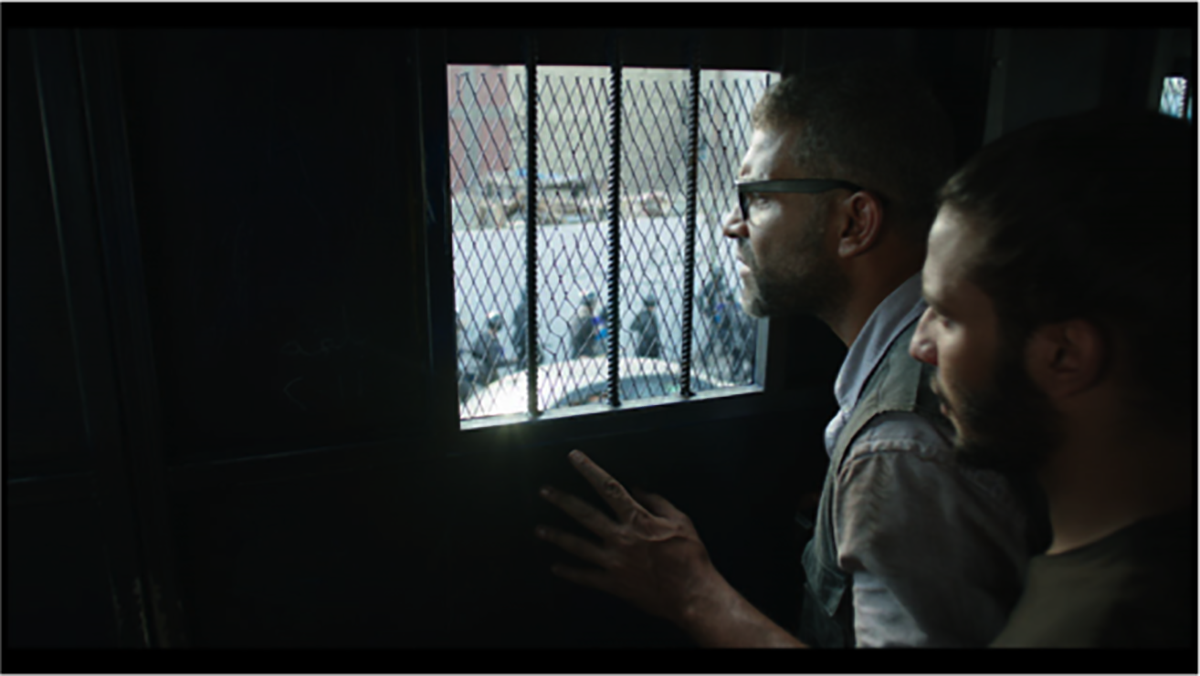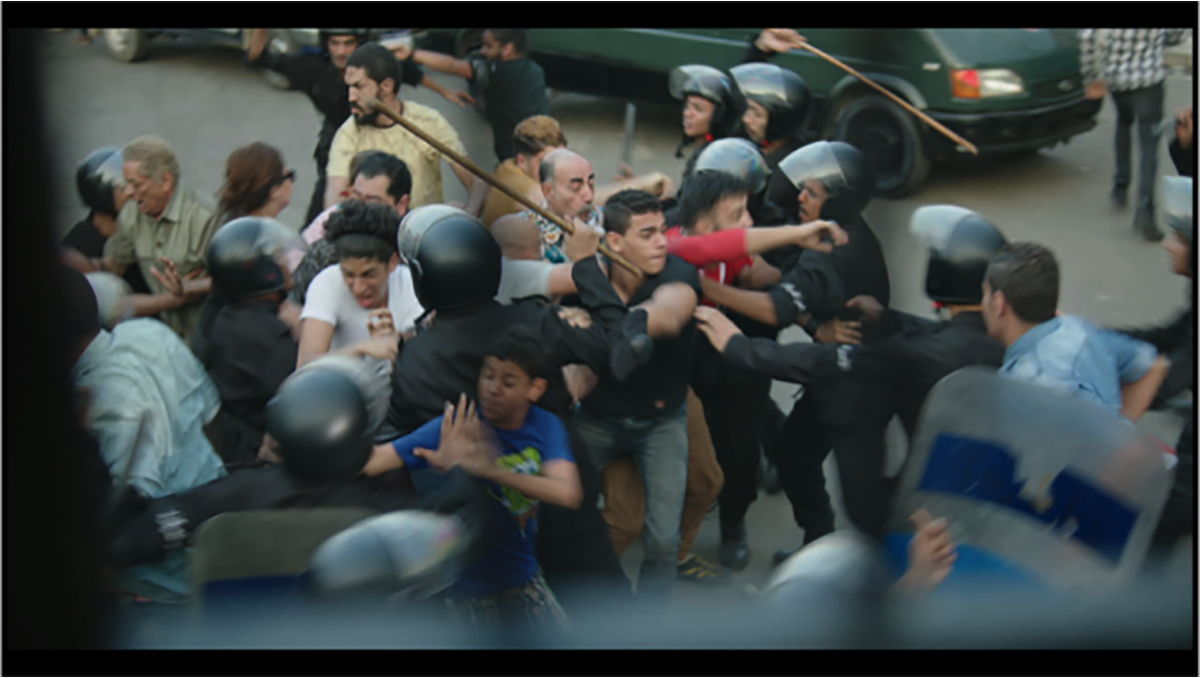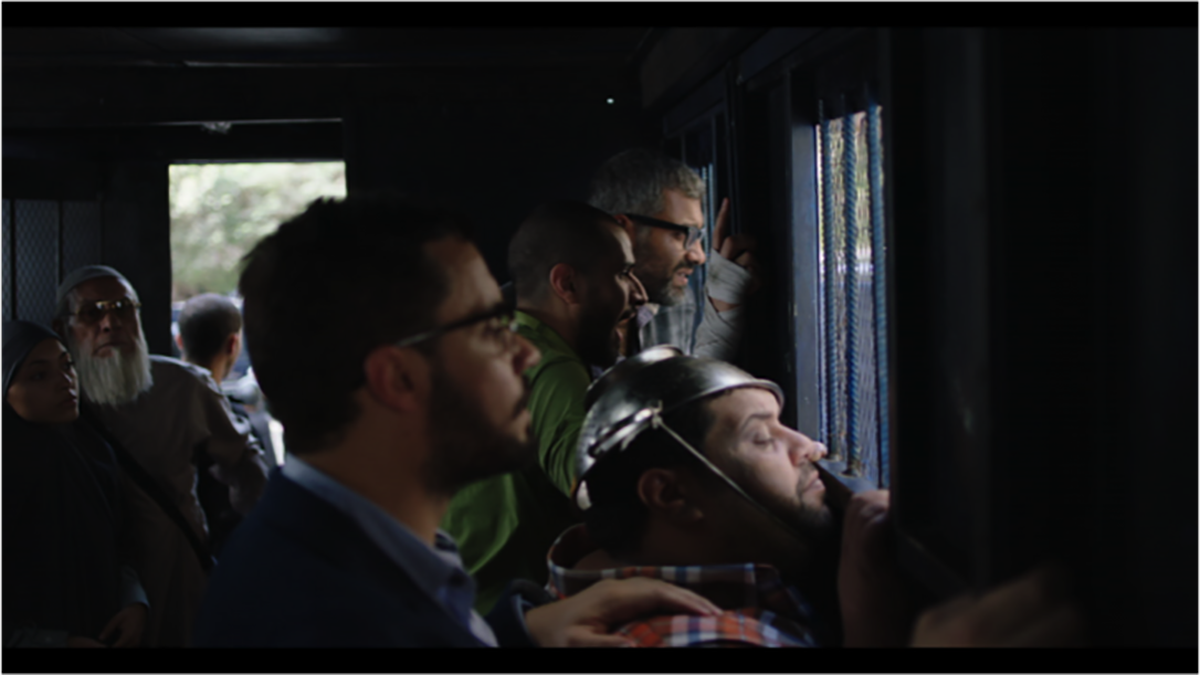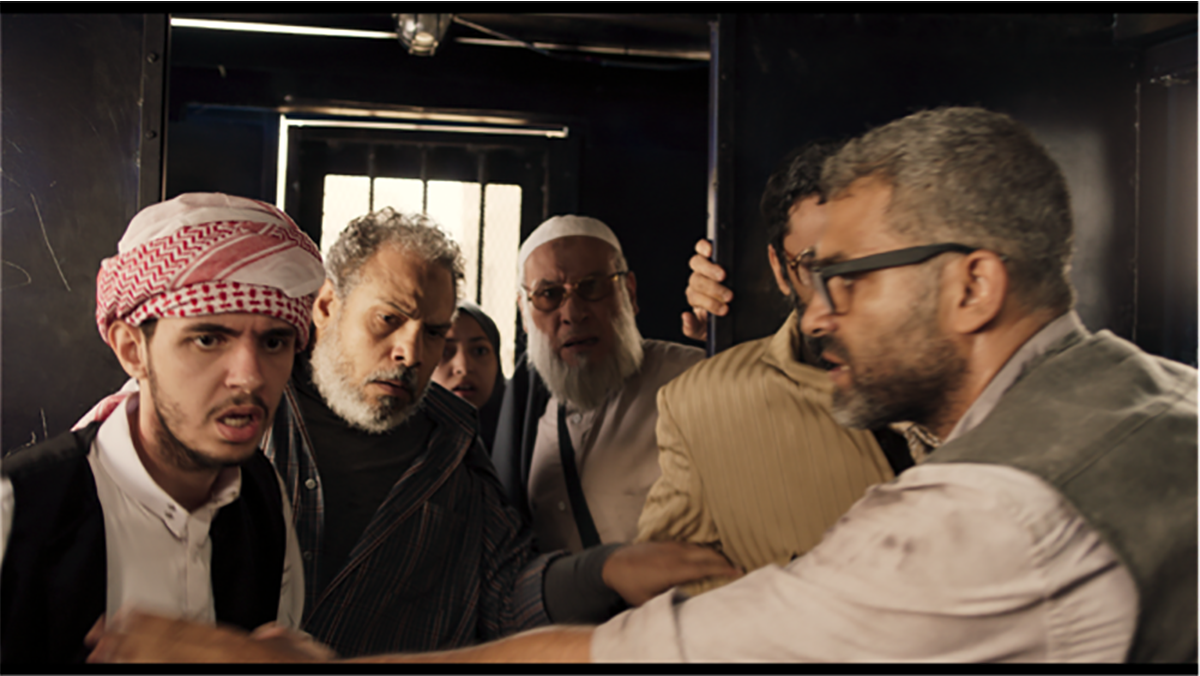As an advocate for the Egyptian revolution, Mohamed Diab was always going to make a movie about the matter in hand. His second feature film, Clash (Eshtebak), takes place in post-revolution Cairo and is, at least according to the director, the first Egyptian film since the 2011 revolution that dares touch on political themes. Despite controversy before its initial release, the film is Egypt’s submission to the 89th Academy Award for Best Foreign Language Film, after opening the Un Certain Regard section at the Cannes Film Festival.
In the aftermath of General Abdul Fatah al-Sisi’s toppling of Mohamed Morsi’s Muslim Brotherhood (MB) government, unrest between MB supporters and opposition grows, culminating in a civil war. People on all sides of the political spectrum are arrested and imprisoned without trial. Clash revolves around a single police van on one eventful Cairo day. A twenty-odd number of people from all walks of life are locked up inside, forming a microcosm of Egypt’s population.
Every scene of the film takes place inside the vehicle or around it, filmed from inside. Since the film is entirely set inside one confined space, it can be lined up in a whole tradition of huis clos (French for closed doors) cinema. Diab and his director of photography Ahmed Gabr used a number of techniques to overcome the particular technical challenges that go hand in hand with the lack of space to move around freely.
Behind Closed Doors
Filmmakers can have various reasons to choose a single location for their film. In the case of some, the size of the budget may impose restrictions as far as location goes. When Richard Linklater made his film Tape (2001) with an estimated budget of $100,000, he had to make every dime count, and renting one motel room instead of clearing several locations for filming will get any director a long way. Other filmmakers may choose to shoot on one location for the sake of breaking cinema’s conventions. One of the merits of the medium is the ability to take the audience from one place to another in the blink of an eye. Choosing not to do so can give your film a more theatrical feel. Illustrative examples are Alfred Hitchcock’s 1948 crime thriller Rope and Roman Polanski’s Carnage (2011). Both are adaptations of plays (Patrick Hamilton’s eponymous play and Yasmina Reza’s God of Carnage, respectively) and are set in an apartment (incidentally both in New York), playing out in real time.
For some films, the choice of a single location is meant to bring an extra layer to the story, for instance a sense of claustrophobia. Most of these aim to make the audience feel locked in, just like the films’ characters. This is where Clash comes into play, as well as Hitchcock’s Lifeboat (1944), Rodrigo Cortes’ Buried (2010), Wolfgang Petersen’s Das Boot (1981) and Samuel Maoz’ Lebanon (2009), the latter two of which were repeatedly cited by Mohamed Diab as big inspirations. Closest to Clash is Lebanon, an Israeli anti-war drama, in which, aside from the opening and closing shots, all the action takes place inside or is viewed from within the confinement of a tank.
Complexities of Confinement
Movies set entirely in one confined space have to take on a number of challenges, especially if, like Diab, the filmmaker chooses not to tinker with the setting in order to simplify shooting, adding fake walls or opening up the ceiling. To make these spatially restricted sets work, very specific blocking is of utmost importance. There has to be a very clear idea of the way in which every person of the cast and crew has to move in order to make sure any of the footage is usable. According to Diab, a big part of this problem was tackled in Clash by building an exact wooden replica of the eight square meter police van a year before filming. Here the team rehearsed extensively, trying things out, adding and deleting characters and making script changes. This way, everyone working on the film knew exactly what to do in which situation, adding up to a fluid choreography, making the actual days of shooting considerably easier.
Preparation is not enough, however, as the right choice of equipment for use in narrow spaces is equally vital. Das Boot’s director of cinematography Jost Vacano modified a handheld camera with gyroscopes to make a smaller equivalent of a Steadicam that was more fitting for close quarters. Clash’s DOP Gabr used one of the smallest professional cameras on the market, the Alexa Mini (18,5cm X 12,5cm x 14cm), to be able to move freely, while taking up as little space as possible.
When set against a relatively monotone background, a film needs to display versatility in other visual aspects to continually stimulate the audience, preferably without lapsing into gimmicks. In that respect, Maoz’ Lebanon, with its even smaller space, does not succeed completely because the camerawork is fairly repetitive. Interiors are largely the same, alternating shot reverse shots and medium shots without any camera movement, while the exteriors are all zoom shots overlaid with crosshairs, something that gets old quickly.
Setting the Tone: the Opening Scene
The very beginning of Clash is representative for the visual style of the rest of the film. The camera starts at the back of the police van’s cell, which is still completely empty, a luxury Gabr will not be able to enjoy again for the rest of the film. With a forward tracking shot, we are brought towards the door and, incidentally, the first couple of detainees to be locked in the vehicle. This one shot, however simple, immediately gives us a very clear idea of the space in which all the action will take place. The camera is clearly handheld and no precautions are taken to stabilize it.

In the same long take we look outside for the first time, over the shoulders of the two prisoners. The take ends abruptly as they are actually thrown into the vehicle, at which point shaky close-ups and more stable wide shots alternate quickly, resulting in a more distorted and disorienting view on the action. After the characters settle, shot length is streched out again, but an even greater variety of shot types is being displayed, as mid shots and insert cuts showing us details of the action in the van are thrown in the mix. Although the handheld cinematography gives the film a documentary-like feel, the fast editing and later the use of music reveal the director’s hand.

Later in the film, more and more demonstrators are plucked off the streets and shoved in the police van, forcing Diab and his DOP to show a more reaching versatility. While close-ups, mid and wide shots and insert cuts are still prominently present, we also get some over-the-shoulder shots during dialogues and cutaways to offer us glimpses outside through one of the nine windows or the door. These are unfailingly restricted by the bars on the window or by the frame of the door, emphasizing the atmosphere of imprisonment. The handheld style of cinematography is maintained throughout the film, making for particularly unstable images when the van starts driving.
Motion or Still: the Use of Long Takes
Not unlike a lot of Hitchcock’s work, Clash contains a great amount of long takes, some extremer than others. Roughly, Diab uses two kinds, the ones with and the ones without camera movement. Long takes are a great way to bring moments of rest in an otherwise action-heavy film, but they are difficult to pull off successfully, maintaining visual variety and catering to the audience’s demand for stimuli. Diab and Gabr have found some fascinating solutions to keep the cinematography coherent yet refreshing, although the director did state that the circumstances were not exactly ideal: “Every time the cameraman is moving, everyone around him has to dance. We had to rehearse it so many times. Everyone had their task of dancing around and then sitting down or standing in their spot again, as if nothing had happened.”
It can be hard not to overwhelm the audience with a screen filled with characters, all deserving of the viewer’s attention. When the point of view is at the back of the van looking towards the front or vice versa, multiple characters are fitted into a single frame, at various distances from the camera. Whenever it is not specifically important to show all the characters clearly, Gabr uses a wider f-stop to achieve a more shallow depth of field, keeping the better part of the frame, and the characters within it, slightly out of focus. By racking said focus back and forth, he guides the audience’s gaze towards the action, be it a character talking, or doing anything else of importance. This way, a single take without any camera movement can show a variety of different images, while also keeping all the action very clear and easy to digest, making it a great alternative for the classic shot reverse shot.

Dynamic long takes are great to show characters together with the events occurring outside. One of the early action scenes takes place at an MB demonstration, intervened on by the police. The take that opens this scene lasts approximately twenty-four seconds. The camera starts out at the back of the cell, at which point there are nine characters on screen, between the DOP and the door. The point of view moves towards the door, while eight of the characters at least partly cross paths with the camera. The action then unfolds outside as seen through the door window, holding the take for several more seconds until it is replaced by a zoom shot. The movement of the camera is very fluid and the view is never hindered by one of the characters. It is a marvelous example of the meticulous preparation and the perfectionistic blocking that went into the film, inside as well as outside the vehicle.

A dynamic long take does not require the camera to move from one point to another; just panning and tilting can achieve a lot. One scene involves a take that lasts for roughly three and a half minutes. The camera pans 360° three times, which makes the scene very easy to process after all the action that came before it. One of the most inventive elements in shots like these is when a pan or tilt is set off by the movement of a character. For instance, a (medium) close-up of one character talking might be followed by a mid or wide shot of another after picking up on his or her – usually lateral – movement.
Der Polizeiwagen
Clash takes on challenges similar to those faced in making Das Boot, Lebanon and Buried, but also Locke, Rope, 12 Angry Men and dozens of other huis clos films, and does so very effectively, displaying true craftsmanship and vision. Versatility in cinematography and editing offers solutions to the monotony of visual settings that comes with this type of filmmaking, while limited mobility is countered with choice of equipment, meticulous preparation and intelligent blocking.
Wolfgang Petersen makes a very clear choice to show most of Das Boot’s dialogue through close-ups, at times awkwardly close, to convey the characters’ feeling of being boxed in, Clash shows its characters in a great range of shot types, all serving their own purpose. Conversations are portrayed in close-up shot reverse shots or in medium shots framing multiple characters, with insert cuts show us details inside the van. Action scenes are edited heavily, whereas long takes slow down the pace, offering the viewer resting points.
Exteriors and interiors in Das Boot and Lebanon are clearly separated by cuts, with the latter always showing the outside through a cross-haired gun sight. In Clash, things are not that clear cut, as many takes involve action inside the vehicle as well as outside. For Diab, it was very important to shoot the interiors and exteriors at the same time: “Every single shot that you see, outside and inside, all the actors are there, in the streets of Egypt as they were. That made it harder, but it gives a more dynamic quality to the film.”
Filming interiors and exteriors at the same time is one of several choices Diab made to make Clash an authentic experience. The average director might open up walls or ceilings to make filming easier, or might choose to use a lot of artificial lighting to save time and effort, but Diab does none of this. DOP Gabr’s handheld style of photography and the incredible long takes add to this feeling of realism and authenticity, while heavy editing keeps the pace up during action scenes. Diab’s near perfect sense of timing in choosing when to use long takes or fast editing and his eye for exactly the right type of shot in any given situation make Clash a justified addition to a select list of films that truly succeed in converting single space drama into a great cinematic experience.